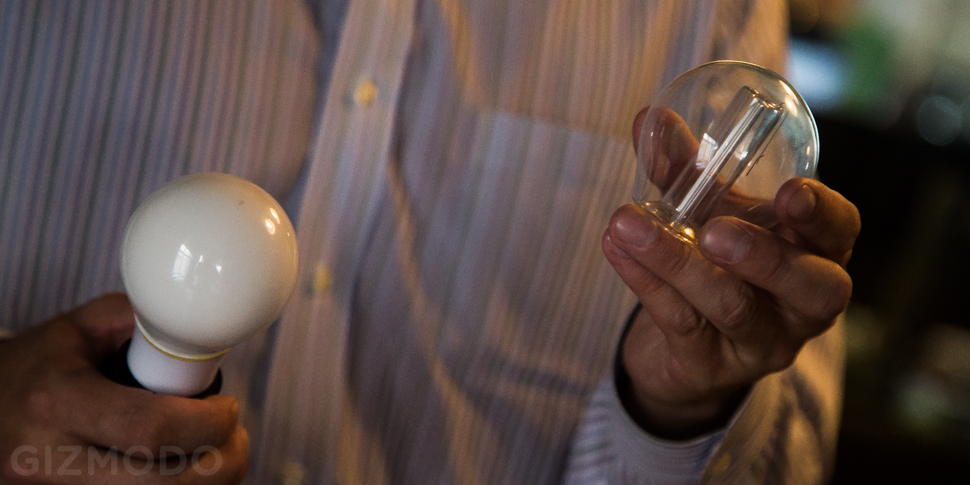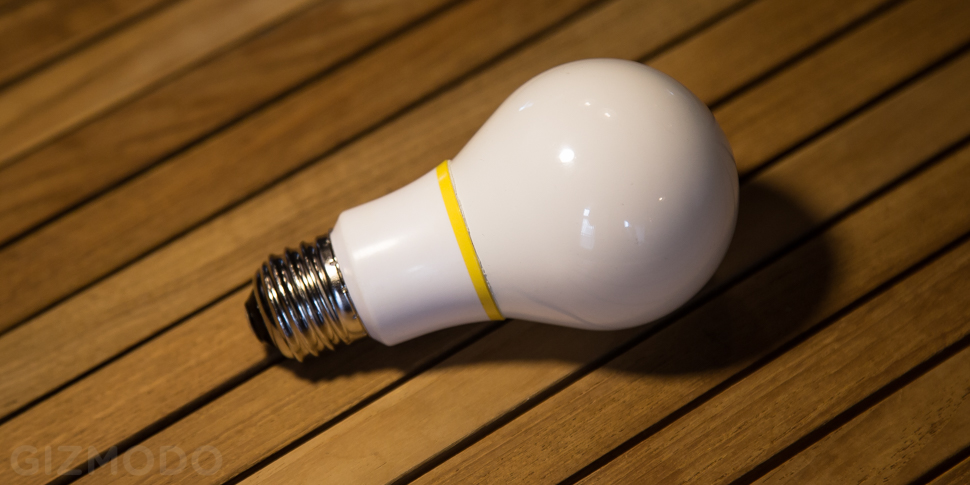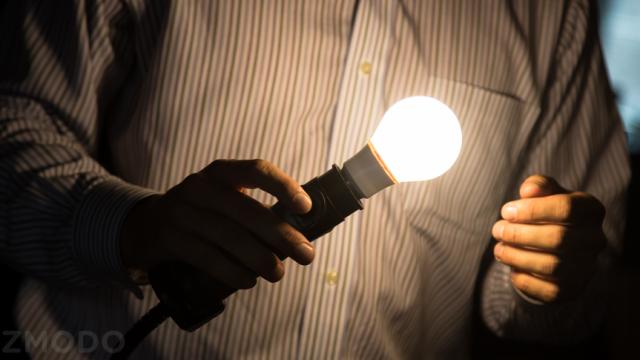Despite their inefficiency, old-school incandescent lightbulbs sure did put out a pleasant, natural-looking light. The folks at Finally Light Bulb missed that light, so they brought it back with an efficient, affordable bulb using technology Nikola Tesla once patented. The team visited our offices to show us the light.
The Finally Light Bulb is a drastically miniaturised induction light, a type used to light skyscrapers, tunnels and warehouses. Induction lights use a magnetic field instead of the failure-prone metal filament of an incandescent, giving a lifespan that can reach 100,000 hours and slashing the incandescent’s 90 per cent energy waste. Unfortunately, industrial induction lights require a brick-sized box of electronic controls, which prevented the tech from reaching household fixtures for years.
Finally Light’s R&D team spent three years trying to cram that box of doodads into the silhouette of the standard size A19 incandescent bulb. Founder and CEO John Goscha told us mobile tech advancement finally made it possible. “Thanks to the cell phone industry, [the components] have come down in size and have come down in cost. It’s really the advancement of general electronics that made this technology possible today when it’s never been possible before.”
That mobile-tech influence helped Goscha’s team shrink that brick’s worth of electronics down to a quarter-sized board. Like its industrial big brothers, the Finally Light’s internal output is mostly invisible UV, which excites the phosphorescent white coating of the glass dome, making it glow bright white, creating the light you see.
Unlike LED fixtures that require heat-dispersing fins that might not fit in an incandescent fixture, the Finally Light’s glass bulb provides all the surface area needed for heat dissipation. After five minutes, the bulb he showed us was warm, but not scalding to the touch — Goscha says the glass hits temps below 160 degrees Fahrenheit, while incandescents can sometimes top 300 degrees. The Finally bulb contains tiny amounts of mercury in alloy with other metals, but it’s federally approved for regular landfill disposal.

Does that glass dome look familiar? It should: Finally Light used the same design as an old-fashioned incandescent. “We were able to utilise all the old incandescent machines that were being shut down, and repurpose them to produce our lightbulb,” Goscha said. “So instead of having to build a billion dollar factory, we’re able to use their technology for us and recycle the old, beat up factories.”
Why not just tweak an LED setup? Goscha says even the creator of the first consumer LED lightbulb thinks the tech is ill-suited to our incandescent-native world.
One of our board members is Ihor Lys, the cofounder of a company called Colour Kinetics, which is now Philips LED. If you go to the Smithsonian, there’s the Edison light bulb, and right next to it is Ihor’s LED light bulb. So he’s credited with inventing the first general purpose LED light bulb. And he said the hardest thing for an LED to do is to be a standard light bulb. You have all this light that’s going in one direction and you’re trying to scatter it out, you’re generating all this heat with all these compact electronics, necessitating a heat sink, so it’s just really hard to do.
The “60 watt equivalent” bulb Goscha showed us turned on instantly and put out a warm, incandescent-esque glow. According to Finally’s spec sheet, the bulb pumps out a full 800 lumens on just 14.5 watts of juice, and is rated to last for 15,000 hours. For comparison, the same output Cree LED that impressed us last year only uses 9.5 watts and is rated for 25,000 hours.
But the Cree’s finned heat diffuser meant it simply wouldn’t fit in some fixtures when we tested it. Finally’s bulb is shaped identically to a traditional A19, so it will fit in any fixture that will take one of the incandescents you started hoarding when President Bush signed the law banning them in 2007.

And then there’s the way the light looks. Lighbulbs are rated on the Colour Rendering Index, or CRI, which quantitatively measures how reference hues look under various lights. Old fashioned incandescents score a perfect 100 on CRI; Finally’s bulb rates an 83, while the comparable Cree comes in at 80. Both bulbs just barely make it under $US10.
And while other bulbs use a fast flicker that some people find unsettling, Goscha says the Finally Bulb’s light output is actually steadier than an incandescent:
I set our specifications that we have to be as good, if not better, than an incandescent light bulb. And we did it. So as far as the flicker, you don’t get the same that you would out of CFLs or LEDs, which are really fast. And some people are pretty sensitive to that. Our visible flicker is zero, and our non-visible flicker, which is something you might see out of the corner of your eye, is lower than what you’d get out of a normal incandescent.
All of which means that deciding between the Finally Bulb and the Cree comes down to specification hair splitting and the matter of fitting. Finally’s 60W equivalent is available for pre-order now, shipping this fall; 75W and 100W equivalents will come later.
We’ll wait to get our hands on a Finally bulb and do some side-by-side testing before we declare a winner in the competition for an energy-efficient incandescent emulator. Right now, we’ll just say you’ve got better options than ever before, and that’s news that will brighten any old-school bulb fan’s day.
